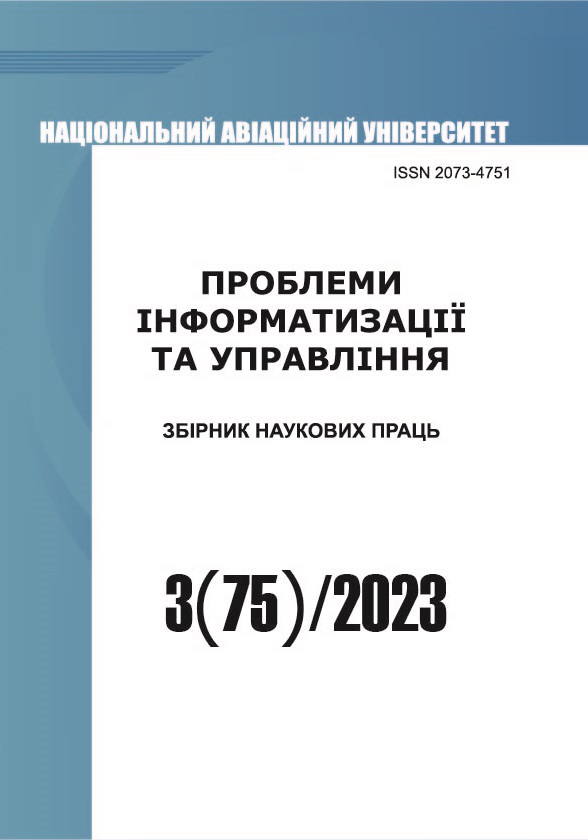Optimization of air traffic control network structures in the presence of energy constraints
DOI:
https://doi.org/10.18372/2073-4751.75.18019Keywords:
heterogeneous networks, network architecture, Saati hierarchy analysis method, decision stabilityAbstract
The article examines the problems of information and telecommunication systems of air transport, which, on the one hand, are hard real-time systems, and, on the other hand, critical application systems. Based on the results of the analysis of promising information and communication and computer networks of critical application, it was found that the main problems for networks are their vulnerability to external interference of various origins, which worsens QoS indicators, in particular, performance. The process of analyzing energy and information characteristics of wireless networks of critical application is considered. The main criteria for assessing the quality of functioning of computerized air traffic control systems have been introduced and substantiated. The multidimensional functionality of the efficiency of the information-computing and control computer network - such a critical application system as the air traffic control system and the information-communication network of the air hub – has been determined. In order to constantly monitor network characteristics at the proper level, a method of calculating the current signal/(interference plus noise) ratio has been developed. According to the results of the analysis of the energy and information characteristics of the network, their relationship is established, which is not always obvious, but very indicative and useful, for example, for solving the tasks of multi-criteria parameter optimization and network state management. The solution to the problem of multi-criteria optimization is achieved due to the scalar approach to vector optimization through the method of analysis of Saati hierarchies. The stability of the solution is ensured by inserting random components into the priority matrix.
References
Satish C. Mohleji, Andrew R. Lacher, Paul A. Ostwald. CNS/ATM System Architecture Consepts and Future Vision of NAS Operations in 2020 Timeframe. American Institute of Aeronautics and Astronautics. 2003. P. 1–10.
Mesarovic M.D., Macko D., Takahara Y. Theory of hierarchical multilevel systems. New York : Academic Press, 1970. 294 p.
Saaty T.L. The analytic hierarchy process. New York : McGeaw Hill, 1980. 288 p.
Ciuonzo D., Rossi P.S. (Eds.) Data Fusion in Wireless Sensor Networks. The Institution of Engineering and Technology, Michael Faraday House, Six Hills Way, Stevenage Herts, SG1 2AY, United Kingdom, 2019. 323 p.
Feng Wu, Jiang Zhu, Zhipeng Xi, Kai Gao. Capacity of Heterogeneous Mobile Wireless Networks with D-Delay Transmission Strategy. Sensors (Basel). 2016. V. 16. 30 p.
Radio Resource Management White Paper. Cisco Systems, Inc., 2018. 52 p.
Frenzel L. Principles of Electronic Communication Systems (5th ed.) McGraw Hill, 2022. 946 p.
Sankararaman A., Baccelli F. Spatial Birth-Death Wireless Networks. IEEE Transactions on Information Theory. 2017. V. 63, Iss. 6. P. 3964–3982.
Xuemin (Sherman) Shen, Xiaodong Lin Kuan Zhang (Eds.) Encyclopedia of Wireless Networks. Springer Nature Switzerland AG, 2020. 1566 p.
Dordal P.L. An Introduction to Computer Networks. 2019. 872 p.
Gentle J.E. Mori Y., Härdle W.K. (Eds.) Handbook of Computational Statistics Concepts and Methods Second revised and updated Eq. Springer, 2012. 1204 p.
Tanenbaum A.S., Wetherall D.J. Computer Networks (5th ed.) Prentice Hall, Cloth, 2011. 960 p.
Kurose J.F., Ross K.W. Computer Networking: A Top-Down Approach. Pearson Education, Inc., 2017. 864 p.
Downloads
Published
Issue
Section
License
Автори, які публікуються у цьому журналі, погоджуються з наступними умовами:- Автори залишають за собою право на авторство своєї роботи та передають журналу право першої публікації цієї роботи на умовах ліцензії Creative Commons Attribution License, котра дозволяє іншим особам вільно розповсюджувати опубліковану роботу з обов'язковим посиланням на авторів оригінальної роботи та першу публікацію роботи у цьому журналі.
- Автори мають право укладати самостійні додаткові угоди щодо неексклюзивного розповсюдження роботи у тому вигляді, в якому вона була опублікована цим журналом (наприклад, розміщувати роботу в електронному сховищі установи або публікувати у складі монографії), за умови збереження посилання на першу публікацію роботи у цьому журналі.
- Політика журналу дозволяє і заохочує розміщення авторами в мережі Інтернет (наприклад, у сховищах установ або на особистих веб-сайтах) рукопису роботи, як до подання цього рукопису до редакції, так і під час його редакційного опрацювання, оскільки це сприяє виникненню продуктивної наукової дискусії та позитивно позначається на оперативності та динаміці цитування опублікованої роботи (див. The Effect of Open Access).


